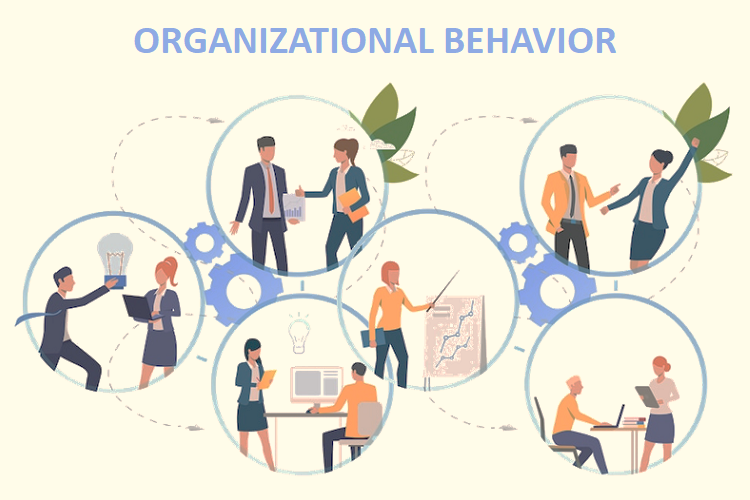Organizational Behavior, abbreviated as OB, constitutes the comprehensive exploration of human behaviors within the intricate framework of organizations. While business cultures may exhibit variances contingent on factors such as company identity, industry nuances, and geographical location, they invariably converge towards the common objective of fostering a positive, productive organizational milieu coupled with elevated employee satisfaction.
Human resources practitioners, managers, and other leadership figures routinely leverage organizational behavior insights to unravel the intricacies of team dynamics, scrutinize organizational conduct, and comprehend the actions of individual employees. This article delves into the essence of organizational behavior, highlighting its significance. Additionally, it explains the basic elements of OB and defines practices for their practical application within the workplace.
Key takeaways:
- Examination of organizational behavior delves into the intricacies of interpersonal interactions among individuals and within group dynamics.
- Professionals in human resources, management, and executive roles frequently leverage organizational behavior (OB) research to discern avenues for enhancing work culture and elevating employee contentment.
- Diverse elements wield influence over organizational behavior in the workplace, encompassing factors such as leadership style and the physical milieu. A nuanced comprehension of these components serves as a navigational tool for enhancing the organizational milieu.
What is organizational behavior?
Organizational behavior is the study of how people interact within groups. It looks at patterns of individual and group behavior, as well as the effect that these behaviors have on an organization’s performance. By understanding organizational behavior, organizations can create a more effective workplace environment and increase productivity.
Organizational behavior focuses on three main areas: attitudes, values, and beliefs; motivation; and communication styles. Attitudes are formed by our experiences in life, including those we have had with other people or situations within an organization. Values refer to what is important to us when making decisions or taking action in organizations – such as honesty or respect for others – while beliefs are our ideas about how things should be done in order to get results from employees or customers. Motivation refers to why individuals choose certain actions over others – whether it’s intrinsic (internal) rewards like recognition from peers or extrinsic (external) rewards like bonuses – which will determine their level of engagement with tasks they need to complete for work purposes.
Finally, communication style plays a major role when it comes to organizational behavior because different types of messages can be interpreted differently depending on who receives them—for example someone may take offense if you use sarcasm during a conversation even though you meant no harm by it! Communication also includes nonverbal cues such body language which can indicate just how interested someone might be in what another person has said without saying anything at all!
Organizational Behavior helps managers understand why employees act the way they do so that they can better manage their teams effectively towards achieving goals set out by senior management team members. This knowledge allows leaders to develop strategies tailored specifically around improving employee morale, increasing efficiency levels across departments, reducing conflicts between colleagues etc. As this field continues growing there has been increased focus placed upon training programs aimed at teaching business owners / executives’ key concepts related to OB & its applications throughout various industries worldwide!
Why is organizational behavior important?
In delving into the realm of organizational behavior, we embark on an exploration of the intricate tapestry of human interaction within group dynamics. The focal point resides in comprehending and orchestrating the nuanced dance of individual and collective behaviors to forge a milieu of productivity within the workplace. The salience of organizational behavior manifests for manifold reasons:
Good relationships in the workplace
A profound grasp of organizational behavior empowers managers to decipher the intricate motivations and conduct of their workforce, fostering enhanced camaraderie. This, in turn, begets an environment conducive to heightened efficacy in communication, collaborative endeavors, adept problem-solving, team fortification, and fortified rapport amongst colleagues and managerial echelons alike.
Create a psychologically safe workplace
Scientific inquiries underscore the correlation between psychologically secure workspaces and elevated job contentment among employees. Such sanctuaries enable individuals to articulate their perspectives sans trepidation of reprisals from superiors or peers. Moreover, when a sense of security pervades, collaborative initiatives thrive, propelling overall organizational productivity. This arises from the proliferation of inventive solutions emanating through collective discourse rather than an autocratic decree from upper-tier management alone.
Equipment with greater efficiency
A meticulous exploration into organizational behavioral facets such as diverse leadership paradigms or decision-making processes provides employers with a toolkit to bolster staff efficiency. This involves imparting techniques that augment efficacy while concurrently curbing errors stemming from the uninformed execution of tasks. The temporal and fiscal dividends are noteworthy, as it mitigates the costs associated with rectifying procedural missteps engendered by a lack of initial comprehensive training.
Employee motivation
Lack of motivation can precipitate employee burnout, as mediocre motivation diminishes work efforts. Organizational behavior studies guide leaders in understanding the motivational tools necessary to achieve peak performance from their employees.
Nature of employees
Employees who radiate positivity contribute significantly to a company’s performance, while stressed employees can disrupt overall effectiveness. Understanding employee behavior at work is critical to success. The study of organizational behavior helps managers unravel the logic behind employee behavior, facilitating a conducive work environment.
Better communication
Effective communication is critical for optimal results, and leaders must engage with their employees first. Employees respond to their environment and leaders with dominant styles can cause frustration. Understanding organizational behavior guides managers and leaders to identify the organizational model in which workers excel.
In essence, the study of organizational behavior emerges as an indispensable compass for navigating the intricate realm of workplace dynamics, fostering an environment conducive to greater efficiency and sustained success.
The Key Elements of Organizational Behavior
Exploring the field of organizational behavior often involves extensive study, perhaps an entire college semester. Despite the abundance of material, the application of organizational behavior theory to the workplace can be summarized into four fundamental elements: people, structure, technology, and environment.
People
The term “people” encompasses the workforce within your organization, who work collaboratively and individually to create the entire structure. The quality of the employees recognized as the primary factor in business is unparalleled. They play a fundamental role in achieving organizational objectives. Promoting a favorable work environment involves paying careful attention to how employees are treated. Understanding individual behavior can help you improve workplace interactions and foster a thriving business.
Structure
Structure revolves around roles and relationships within an organization. Clearly defining an employee’s role improves work efficiency and reduces confusion. Engaging employees in work as per their skills contributes to the achievement of business objectives.
Technology
Incorporating essential technology into business operations improves work performance and overall effectiveness. Technology not only provides different machines, tools and resources but also introduces different ways of working. The scope of technology required depends on the workload. While technology plays an important role in improving work quality and reducing production costs, caution is necessary to avoid undue interference in the workplace, which may limit employee freedom.
Environment
The business environment includes both internal and external factors. Organizations, unable to thrive in isolation, are influenced by environmental factors such as government, society, family and other organizations. Organizational culture underpins the internal environment, while the external environment includes political, social, cultural, and economic factors. A thorough examination of these factors is necessary for the company’s benefit, which will lead to necessary adjustments if deemed appropriate.
In short, these four elements (people, structure, technology, and environment) collectively form the core of organizational behavior and guide the application of the theory within the dynamic landscape of the workplace.
Levels of organizational behavior
By studying organizational behavior in depth, organizations can better understand why employees act in certain ways or respond to different situations differently. This knowledge can then be used to create more effective policies and procedures for improving employee engagement and productivity.
Organizational behavior exists at three distinct levels – individual level; group level;and organizational-level.
Individual level
The initial level of analysis of organizational behavior focuses on the individual level. Here, the discipline studies the behavior of individual people in depth, taking an in-depth look at aspects such as attitudes, motivation, perception, personality, values, ethics, satisfaction and other personal qualities.
Psychology plays a fundamental role in this analysis, recognizing the natural variation in individual behavior influenced by social, cultural and other contextual variables.
Managers, based on their insight, knowledge and psychological experience, carefully examine the unique qualities and characteristics of each employee. This understanding equips managers with the knowledge to design better and positive approaches to organizational systems.
Group level
Moving to the group level, organizational behavior extends its reach to the behavior of individuals within groups and teams. This analysis includes understanding group work dynamics, collaborative interactions, decision making processes, and much more.
Groups, whether small or large, formal or informal, come together for a common purpose. The study at this level is based on sociology, social psychology and anthropology, throwing light on group dynamics, organizational conflict, politics, communication and related aspects.
Managers equipped with knowledge about group behavior can develop effective strategies for managing groups within the organization and providing expert leadership.
Organizational level
The final level of organizational behavior focuses on an overall understanding of how the organization operates. It examines how individuals interact with organizational structures, the interpersonal relationships between the organization and its members, and the impact of external environmental forces on the organization.
Key variables come under scrutiny including work environment, organizational structure, culture, change, policy and internal/external environment. This level essentially examines the art of effectively managing individuals, groups or teams within the organization. Sociology, anthropology and political science emerge as important disciplines that contribute to this broader level of analysis.
Understanding organizational behavior at this level allows managers to evaluate the performance of individuals and groups, thereby developing strategic plans, policies, motivation programs, work design, change management initiatives and much more to ensure the smooth functioning of the organization. Facilitates development.
In short, these three levels of organizational behavior provide a nuanced lens through which managers can better understand each employee, create enthusiastic group dynamics, and assign organizational tasks that enhance the ability to accomplish work.
Models of Organizational Behavior
Organizations often adopt different leadership models to shape their management approach, each incorporating unique principles and strategies. Let’s take a look at some notable leadership models that have left their mark on organizational structures.
Autocratic model
The autocratic model depends on force, power, and legal authority. In this model, owners, armed with legal authority, manage operations while exercising significant control over employees. Lower-level employees have limited control over results, and important decisions come from upper management. This autocratic style, which was prevalent during the Industrial Revolution, assumes that management has superior business acumen, requiring complete control over less knowledgeable employees. However, this often leads to decreased employee morale, performance, and satisfaction.
Custody model
Born from the limitations of the autocratic model, the custody model addresses employee frustrations and insecurities by focusing on individual needs. This model implements welfare packages such as health and retirement plan as incentives to encourage loyalty. In contrast to the autocratic model, loyalty is directed towards the organization rather than specific leaders. Custodial efforts are aimed at creating a sense of safety and well-being among employees.
Supportive model
In the words of Rensis Likert, the advocacy model focuses on leadership rather than money or power. It seeks to ensure that every interaction within the organization is perceived as useful and contributes to a sense of value and personal importance for each member. By relying on supportive leadership, this model attempts to improve job satisfaction and engagement among employees.
Collegial model
The collegiate model, which complements the solidarity model, encourages cooperation between employees and management. Rooted in the idea of a common purpose, this model seeks to create a collaborative environment where both parties feel equal contributors, thereby creating mutual respect. This results in greater job satisfaction and commitment from employees who see themselves as valuable contributors to the organization.
System model
The systems model establishes a cultural foundation and team environment that includes policy, management, and communication. This model revolves around integrating employee skills to facilitate organizational objectives. By seeking alignment between employees and the organization, the systems model aims to create synergy that leads to the achievement of common objectives.
In short, these different leadership models reflect the changing nature of organizational structures, each offering a unique approach to leadership, employee engagement, and achieving collective goals. Selecting a specific model often depends on the organization’s values, goals, and desired work culture.
Goals of Organizational Behavior
Within the scope of organizational changing aspects, we find an applied science known as organizational behavior, which highlights the complexities of both individual and collective behavior within organizational structures. The four major objectives of this discipline include describe, understand, predict and control.
To describe
Chief among these goals is the effort to clearly characterize how individuals behave in different situations. As a managerial person, I am aware of the tendency of a typical junior officer to come late and leave the office early.
To understand
The second aspiration within organizational behavior is to understand the underlying motivations that guide human actions. Managers are tasked with understanding the reasoning behind specific behaviors. For example, as a manager, it is imperative to find out the root cause behind a junior officer’s habitual lateness and untimely departure.
To predict
The third aspect of organizational behavior revolves around predicting the future behavior of employees. Managers often have the ability to gauge employees’ loyalty to the organization. For example, understanding why an employee is considering leaving my organization, devising strategies to retain the employee within the organization, and understanding my role in this scenario becomes paramount.
To control
The ultimate goal of organizational behavior is to establish control and promote a pleasant environment within the organization. Since managers are responsible for the end-to-end performance of an organization, it becomes imperative to develop teamwork, enhance skills, and create unwavering commitment among the workforce. Managers should proactively take necessary measures. In the above scenario, this could include increasing the employee’s compensation if it is unsatisfactory, providing assistance to resolve personal problems, or engaging in negotiations to resolve organizational challenges.
As a result, organizational behavior emerges as a tool to be used for the progress of humanity. Its primary utility lies in analyzing human behavior across multiple organizational scenarios spanning businesses, government agencies, educational institutions, and service-oriented organizations. Managing human resources efficiently requires deep understanding: explaining, understanding, predicting and controlling human behavior.
Conclusion
The main motivation for delving deeper into the realm of organizational behavior (OB) lies in developing a work environment that is not only productive but also promotes strong well-being. Leaders, as pioneers, should initiate organizational behavior research efforts to extract the optimum potential of their workforce. Additionally, if there is a need to improve customer service or improve ethical standards, leaders should actively pursue those initiatives.
This comprehensive article carefully explores each aspect of organizational behavior, summarizing its meaning, purposes, classifications and models.
Reading this article can be informative and enjoyable. Don’t hesitate to spread this informative piece among your acquaintances.




